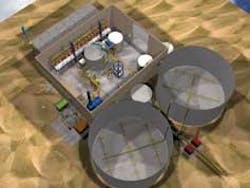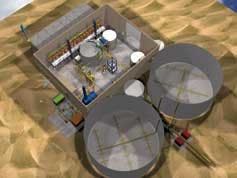Energy, Environmental Efficiency Result from Food Plant Upgrade
Kraft Foods, New York state officials and representatives of Ecovation Inc. marked the commissioning of an innovative food wastewater treatment facility at the Kraft Foods Campbell, NY, plant at the end of July. The water treatment and cheese whey anaerobic treatment system, designed and operated by Ecovation reduces cheese plant waste strength by more than 90% and sets the stage for installation of new equipment to capture and use waste treatment gases to generate electricity.
As such, Ecovation CEO Diane Creel said a major supporter of the project has been the New York State Energy Research and Development Authority (NYSERDA). NYSERDA president Peter R. Smith said his organization has worked with Ecovation engineers for several years to develop food processing waste treatment strategies.
"This project began in 2001 as a commercial-scale pilot facility, and has become an important waste-treatment benchmark for the dairy and cheese industry all across the state," he said.
The next phase – expanding capacity and installing a co-generation system that uses methane gas to generate electricity and heat for plant processing – is now finally possible.
To that end, the state awarded a $960,000 NYSERDA contract to Ecovation to install a combined heat and power (CHP) generation system, valued at $2,399,979, for the Campbell plant. The system will generate 1 megawatt of electricity and simultaneously provide heat for plant processing. This represents about a 70% efficiency gain over traditional electric power consumption, and will help control energy costs and benefit the environment by reducing landfill disposal volume and costs. It also permits retirement of a less-efficient natural gas-fired boiler.
State Agriculture Commissioner Nathan L. Rudgers said: "While the agricultural industry in New York produces a wholesome and abundant food supply, the leadership and support provided by Governor Pataki and NYSERDA have made our industry more efficient. These systems recycle waste to fuel, and help business meet energy needs through the use of anaerobic treatment. Manure from dairy farms, and now whey waste from cheese processing, is being converted to fuel and power, and I applaud this smart use of resources that will help make this state more energy independent in the future."
All NYSERDA Energy Smart programs are funded by a system benefits charge paid by electric distribution customers of Central Hudson, Con Edison, NYSEG, Niagara Mohawk, Orange and Rockland, and Rochester Gas and Electric. NYSERDA, a public benefit corporation established in 1975, administers SBC funds and programs under an agreement with the state Public Service Commission.
For more information, visit www.ecovation.com

